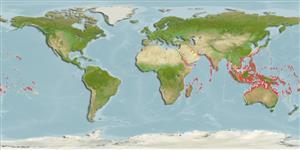>
Eupercaria/misc (Various families in series Eupercaria) >
Labridae (Wrasses) > Corinae
Etymology: Halichoeres: Greek, als, alis = salt + Greek, choiros = pig (Ref. 45335).
More on author: Lacepède.
Environment: milieu / climate zone / depth range / distribution range
Ecología
marino asociado a arrecife; rango de profundidad 0 - 40 m (Ref. 128797), usually 1 - 30 m (Ref. 27115). Tropical; 24°C - 28°C (Ref. 27115); 32°N - 28°S, 34°E - 134°W
Indo-Pacific: Red Sea south to Sodwana Bay, South Africa and east to the Line, Marquesas and Tuamoto islands, north to southern Japan, south to the southern Great Barrier Reef.
Length at first maturity / Tamaño / Peso / Age
Maturity: Lm 12.8 range ? - ? cm
Max length : 27.0 cm TL macho / no sexado; (Ref. 2334)
Espinas dorsales (total): 9; Radios blandos dorsales (total): 11; Espinas anales 3; Radios blandos anales: 11. Some geographical variations between Indian and Pacific Ocean and Red Sea. Adults with one or two yellow saddles over the back and sometimes with small black spot on upper peduncle. Small juveniles black and white, gradually changing with growth to adult pattern (Ref. 48636).
Inhabits sand patches of lagoon and seaward reefs to at least 30 m (Ref. 1602); also on slopes to moderate depths along drop-offs (Ref. 48636). Juveniles common at the bottom of surge channels (Ref. 9710). Feeds mainly on hard-shelled prey, including mollusks, crustaceans and sea urchins (9823).
Life cycle and mating behavior
Madurez | Reproducción | Puesta | Huevos | Fecundidad | Larva
Distinct pairing during breeding (Ref. 205).
Randall, J.E., G.R. Allen and R.C. Steene, 1990. Fishes of the Great Barrier Reef and Coral Sea. University of Hawaii Press, Honolulu, Hawaii. 506 p. (Ref. 2334)
IUCN Red List Status (Ref. 130435)
Threat to humans
Harmless
Human uses
Pesquerías: escaso valor comercial; Acuario: Comercial
Más información
ReferenciasAcuiculturaPerfil de acuiculturaRazasGenéticaElectrophoresesheritabilidadEnfermedadesProcesamientoNutrientsMass conversion
Herramientas
Special reports
Download XML
Fuentes de Internet
Estimates based on models
Preferred temperature (Ref.
123201): 24.8 - 29, mean 27.6 °C (based on 978 cells).
Phylogenetic diversity index (Ref.
82804): PD
50 = 0.5000 [Uniqueness, from 0.5 = low to 2.0 = high].
Bayesian length-weight: a=0.00933 (0.00538 - 0.01619), b=3.09 (2.94 - 3.24), in cm total length, based on LWR estimates for this species & Genus-body shape (Ref.
93245).
Nivel trófico (Ref.
69278): 3.4 ±0.42 se; based on food items.
Generation time: 1.5 ( na - na) years. Estimated as median ln(3)/K based on 1
growth studies.
Resiliencia (Ref.
120179): Alto, población duplicada en un tiempo mínimo inferior a 15 meses (K=0.7).
Fishing Vulnerability (Ref.
59153): Low vulnerability (21 of 100).
Nutrients (Ref.
124155): Calcium = 72.3 [43.5, 119.1] mg/100g; Iron = 0.742 [0.433, 1.311] mg/100g; Protein = 18.7 [15.8, 20.9] %; Omega3 = 0.145 [0.096, 0.223] g/100g; Selenium = 30 [19, 52] μg/100g; VitaminA = 77.2 [25.7, 278.1] μg/100g; Zinc = 1.44 [1.02, 2.23] mg/100g (wet weight);
